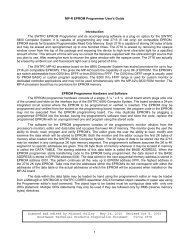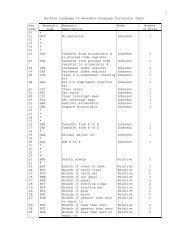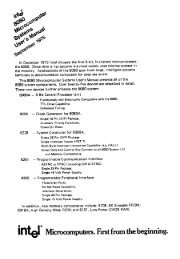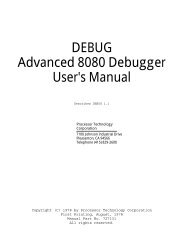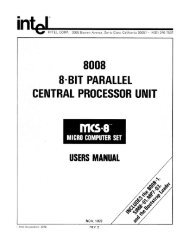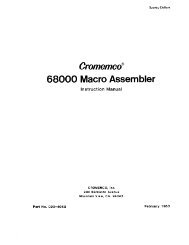The System Manual of SOL-20 - History of Computers
The System Manual of SOL-20 - History of Computers
The System Manual of SOL-20 - History of Computers
You also want an ePaper? Increase the reach of your titles
YUMPU automatically turns print PDFs into web optimized ePapers that Google loves.
PROCESSOR TECHNOLOGY CORPORATION<br />
Sol THEORY OF OPERATION<br />
SECTION VIII<br />
!φ2 respectively. This circuit thus generates a symmetrical two phase<br />
clock, with each phase having a 6 usec period with a 1.5 usec negative<br />
going pulse.<br />
!φ1 advances the cascaded ripple counter, U5 and 6, in the<br />
Column Scanner circuit (U5, U6, NAND gates U4 and decoders U17 and<br />
U21). U6 divides !φ1 by two on each advance. <strong>The</strong> output on pin 12 is<br />
consequently a square wave with a 12 usec period, the output on pin 9<br />
is a square wave with a 24 usec period, and so on to pin 11 which has<br />
a 96 usec period. <strong>The</strong> output on pin 11 is then divided by two in U5<br />
to provide 192, 384, 760 and 1536 usec periods. We will call these<br />
Clock_1 for the 12 usec period, Clock_2 for the 24 usec period, Clock_<br />
4 for the 48 usec period, and so on from Clock_8, _16, _32, _64 and _128.<br />
Clocks_16, _32 and _64 are applied to the A, B and C inputs <strong>of</strong><br />
binary-to-decimal decoders U17 and U21. In order for these decoders<br />
to yield outputs, their D inputs (pin 12) must be low. U4 is used to<br />
enable one or the other <strong>of</strong> these inputs, with Clock 128 being the determining<br />
factor. When Clock_128 is low, U17 is selected through U4<br />
when !φ1 is high at pin 4 <strong>of</strong> U4. U21 is selected when Clock_128 is<br />
high and !φ1 is high at pin 13 <strong>of</strong> U4. By AND’ing !φ1 and Clock_128,<br />
neither decoder is selected when !φ1 is low, the time U5 and U6 count.<br />
During this time false binary signals can appear on the outputs <strong>of</strong> U5<br />
and 6.<br />
<strong>The</strong> net effect is that only one <strong>of</strong> the 15 outputs from U17<br />
and 21 will be low, and this low advances on each count advance. <strong>The</strong><br />
low outputs <strong>of</strong> U17 and 21 drive the column lines in the key switch<br />
matrix.<br />
Clocks_1 through _8 are connected to analog multiplexers U19<br />
and U22. Only one channel from input to output is connected at one<br />
time. Note that Clock_8 and !Clock_8 from U6 enable U19 and U22 respectively.<br />
U19 and U22 (the Row Scanner) thus scan through the 16<br />
rows in the sequence indicated by the numbers contained within the<br />
"boxes" <strong>of</strong> the key switch matrix. An entire scan <strong>of</strong> the rows is made<br />
before the next column is selected by U17 and 21.<br />
We now have U17 and U21 driving the column lines and U19 and<br />
U22 testing each row line by connecting it to an input to the Capacitance<br />
Key switch (KTC) Detector. <strong>The</strong>se two inputs are normally high<br />
at 5 volts. Within the switch matrix there is a small capacitance<br />
connected between each column and row line; that is, there is a capacitance<br />
associated with each key on the keyboard. When a key is depressed<br />
on the keyboard, the capacitance associated with that key increases.<br />
When the column and row lines associated with that key are<br />
selected, there is a significant voltage difference between the two<br />
and the capacitance charges to produce a small negative going spike<br />
at the input to the Capacitance Keyswitch Detector.<br />
VIII-40



